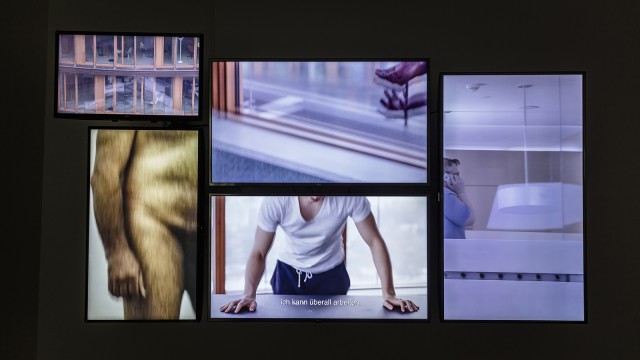_2018_1600x900_image_w640_m.jpg)
Works in the Collection
In the 1960s, the development of happening and performance art was accompanied by the revolutionary invention of video technology, which enabled almost simultaneous recording and playback of images, thus delivering a previously unknown real-time experience. While the new action-oriented art forms were aimed at extending artistic practice into the public sphere and its institutions in order to have a critical effect on culture and society there, video technology also allowed the scope for artistic activity to be expanded, resulting in new image worlds that relate to the technological properties of the medium itself as well as articulating the artistic subject as the protagonist of media-based self-exploration and self-awareness. In the further course of artistic agendas, both performance art and new technologies illustrated that any definition of self, identity, and subject must always be regarded as a social construct that is additionally conditioned by gender-specific attributions. Artists such as Valie Export, Eleanor Antin, Bruce Nauman, Chris Burden, Ulrike Rosenbach, and Joan Jonas were pioneers of this with their works in the field of video art in the 1960s and 1970s. Therefore, the human subject in art came to be interpreted in numerous ways, shifting the focus away from the subject itself towards the forms of subjectification. In addition, development steps of this subjectification gained a pointed nomenclatura, for instance as a result of the research by the sociologist and historian Richard Sennett. In his book "The Corrosion of Character" (1998), he describes the consequences of the postmodern world of work in neoliberal societies: for individuals, these are characterized by flexibility, motivation, self-optimization, creativity, and competition. Overall, these requirements for the subject in turn determine identity and cognitive processes and necessitate a self-description in order to determine its relationship to the surroundings, based here on the example of the world of work.
Anna Witt’s artistic method entwines the structural forms of performance with the functional characteristics of cinematic narrative that are made readily available by the medium of video. Witt uses the medium as a tool in such a way that her films convey considerable immediacy and a large degree of neutrality. Consequently, attention is always drawn to the action itself, which happens within a thematically outlined framework as a direct result of subject relationships and actions rather than in the role-play of staged drama. This still applies when – like for the five-channel video installation "Körper in Arbeit / Body in Progress" (2018) – film sequences are visible in parallel on five monitors that show close-up and long-distance views of “bodies in progress”, in their surroundings or in detail.

_2018_b_1600x900_aw_image_w640_m.jpg)
_2018_b_1600x900_aw_image_w640_m.jpg)
_2018_b_1600x900_aw_image_w640_m.jpg)
The video work was produced in and around the "Erste Campus" in Vienna; in an urban development area around the new main railway station, where the Austrian bank "Die Erste" moved into its new headquarters in 2016. Therefore, the location provides an initial operational framework in which a wide range of working patterns and tasks are carried out simultaneously. People work there on building sites as well as in hotels and offices, with the workstations in the bank’s "Erste Campus" being predominantly organized in open-plan offices in line with the “hot desking policy”: instead of fixed workstations, there is a choice of furnished work areas that are used on a task-specific basis. For the now nomadic employees, the one constant of this flexibly arranged working environment is a personal, lockable container for their essential devices and documents. Consequently, a tenet of this “new work” concept, that of agility, is influencing both the execution of the project in teams and has a material impact on the employees’ world. Anna Witt contrasts workstations structured according to the principle of agility with athletes in a calisthenics group who were specially invited for the video production. They carry out their bodyweight training in the "Die Erste" building just as well as on the surrounding building sites or in hotel corridors. New work models, as they represent themselves to the flexible, agile worker, ultimately find their equivalent in the image of fitness that, having long ceased to be the sole preserve of leisure, is now part of a lifestyle concept with the aim of self-optimization. Text sequences taken from interviews conducted by Witt with the athletes, blue-collar and white-collar employees, and a talent recruiter supplement the video images with statements on their individual self-image, questions, doubts, and goals.

The video piece “60 Minutes Smiling” (2014) is also set in the world of work. It shows a group of men and women whose understated, respectable clothing suggests white-collar employees in the service sector. Moreover, their positioning and posture are balanced so as to give the impression that this encounter is an appointment for an official team portrait taken for a company brochure or the like. The requisite friendly, winsome smile is essential to this. The operational setting of the video that Anna Witt has provided for the invited performers now stipulates that the smile, that positive sign of non-verbal communication, must be maintained for a 60-minute period. Witt therefore plays the real-time technology of the video against the lively mobility of emotions, with the result that the smile increasingly comes across as a strain and a burden, because what was originally a natural moment of expression is extended by an unnatural period. This reflects a mathematics of feelings that is typical of the entire world of work, in order to meet the requirements of service-oriented customer-friendliness. The strategic laws of the world of work have already usurped the emotions of the subject, framing the subject as human capital in the context of the world of work for corporate purposes. The abridged video version of “Sixty Minutes Smiling”, 2014, gives a glimpse into this video piece. (©Anna Witt, courtesy of the artist and Galerie Tanja Wagner, Berlin).
Biography
Anna Witt (*1981): Born in Wasserburg am Inn. 2002–2008 Studies at the Akademie der bildenden Künste Wien under Monica Bonvicini and at the Akademie der Bildenden Künste München under Magdalena Jetelová and Asta Gröting. 2003 While studying, produces her first video "Die Geburt", in which Witt and her mother re-enact her birth in 9 minutes. 2005 Full scholarship from the Studienstiftung des deutschen Volkes. Witt starts working in the public sphere with passers-by, and produces the videos "Kontakte” (2005) and "Push" (2006). 2006 Features in the exhibition "Traurig sicher, im Training" at Grazer Kunstverein, Steirischer Herbst, Graz. 2008 Included in Manifesta 7, Trentino, South Tyrol. 2010 Austrian state scholarship for video and media art, first institutional solo exhibition at Lothringer 13, Städtische Kunsthalle München, and features at the 6th Berlin Biennale. 2012 Work scholarship, TICA-Tirana Institute of Contemporary Art, Albania; Bayerischer Staatsförderpreis, performance section. Between 2008 and 2012, produces video works on the topics of migration, self-observation and observation by others, and forms of re-enactment and self-empowerment. 2014 Work grants in Chisinau, Moldova; Goethe Institut Sofia, Bulgaria; Stacion, Center for Contemporary Art, Pristina, Kosovo. 2015 Work scholarship Atelier Tokyo, BKA Austria. 2015–2016 One-year project in collaboration with Ahsraf Jabal and Alexa Dreesmann on their experience of fleeing from Syria and the GDR. The resultant multimedia installation “Walking Through Walls” is presented at the Galerie für Zeitgenössische Kunst in Leipzig in 2015. 2016 Solo exhibition at the Kunsthalle St. Gallen. 2018 Solo exhibition “Human Flag”, Belvedere 21, Vienna; Msgr. Otto Mauer-Preis für Bildende Kunst. 2019 Nanji residency scholarship, Seoul Museum of Art. 2020 Austrian state prize “Outstanding Artist Award”, video and media art section.
